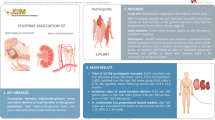Abstract
Altered blood viscosity (BV) may affect blood pressure (BP) and develops further complications in diabetes. A case-control study was performed to examine the relationship of erythrocyte sedimentation rate (ESR), hematocrit, fibrinogen, and BV with glycemic markers and BP in middle-aged normotensive and hypertensive type 2 diabetic patients and healthy controls. A total of 145 participants between age group 30–50 years divided into three groups; controls (n = 60), type 2 diabetes mellitus (T2DM, n = 55), and T2DM with hypertension (T2DM + HTN, n = 30). ESR and hematocrit were determined by Wintrobe’s method. Plasma fibrinogen was measured using Lempert method and BV calculated using Merill’s formula. T2DM and T2DM + HTN patients had higher fasting plasma glucose (FPG), glycated hemoglobin (HbA1c), systolic BP (SBP), diastolic BP (DBP), mean arterial pressure (MAP), ESR, and fibrinogencompared to controls. In both male and female SBP, DBP, MAP, FPG, and HbA1c were significantly higher in T2DM and T2DM + HTN groups, compared to controls. Further, linear regression analysis revealed a positive association of ESR and fibrinogen with SBP, DBP, MAP, FPG, HbA1c, and positive diabetic status in all participants. Also, in the same analysis, BV showed a positive association with SBP, DBP, and MAP. The association of ESR and fibrinogenwith glycemic markers and BP in diabetes supporting the value of emerging marker’s for early prediction of T2DM and hypertension.
Similar content being viewed by others
References
Dhas Y, Mishra N, Banerjee J. Vitamin D deficiency and oxidative stress in type 2 diabetic population of India. Cardiovasc Hematol Agents Med Chem. 2016;14(2):82–9.
Adela R, Borkar RM, Bhandi MM, Vishwakarma G, Reddy PN, Srinivas R, et al. Lower vitamin D metabolites levels were associated with increased coronary artery diseases in type 2 diabetes patients in India. Sci Rep. 2016;6:37593–606.
Salazar-Vazquez BY, Intaglietta M, Rodriguez-Moran M, Guerrero-Romero F. Blood pressure and hematocrit in diabetes and the role of endothelial responses in the variability of blood viscosity. Diabetes Care. 2006;29(7):1523–8.
Gyawali P, Richards RS, Nwose EU, Bwititi PT. Whole-blood viscosity and metabolic syndrome. Clin Lipidol. 2012;7(6):709–19.
Irace C, Carallo C, Scavelli F, De Franceschi MS, Esposito T, Gnasso A. Blood viscosity in subjects with normoglycemia and prediabetes. Diabetes Care. 2014;37(2):488–92.
Marini MA, Fiorentino TV, Andreozzi F, Mannino GC, Succurro E, Sciacqua A, et al. Hemorheological alterations in adults with prediabetes identified by hemoglobin A1c levels. Nutr Metab Cardiovasc Dis. 2017;27(7):601–8.
Brun JF, Aloulou I, Varlet-Marie E. Type 2 diabetics with higher plasma viscosity exhibit a higher blood pressure. Clin Hemorheol Microcirc. 2004;30:365–72.
Mishra N, Singh N. Blood viscosity, lipid profile, and lipid peroxidation in type-1 diabetic patients with good and poor glycemic control. N Am J Med Sci. 2013;5(9):562–6.
Minato S, Takenouchi A, Uchida J, Tsuboi A, Kurata M, Fukuo K, et al. Association of whole blood viscosity with metabolic syndrome in type 2 diabetic patients: independent association with post-breakfast triglyceridemia. J Clin Med Res. 2017;9(4):332–8.
Tamariz LJ, Young JH, Pankow JS, Yeh HC, Schmidt MI, Astor B, et al. Blood viscosity and hematocrit as risk factors for type 2 diabetes mellitus: the atherosclerosis risk in communities (ARIC) study. Am J Epidemiol. 2008;168:1153–60.
Wilson PW, McGee DL, Kannel WB. Obesity, very low-density lipoproteins, and glucose intolerance over fourteen years: the framingham study. Am J Epidemiol. 1981;114:697–704.
Tulloch-Reid MK, Hanson RL, Saremi A, Looker HC, Williams DE, Krakoff J, et al. Hematocrit and the incidence of type 2 diabetes in the pima Indians. Diabetes Care. 2004;27:2245–6.
Vazquez BY. Blood pressure and blood viscosity are not correlated in normal healthy subjects. Vasc Health Risk Manag. 2012;8:1–6.
Lampert VH. Practical clinical biochemistry, Plasma fibrinogen estimation by Tyrosine method. 4th ed. New Delhi: CBS Publisher; 1988. p. 244–5.
Odusan O, Raimi HT, Familoni OB, Olayemi O, Adenuga JO. A study of hemorrhological parameters as risk factors for cardiovascular diseases in Nigerian type 2 diabetes mellitus patients. Nig J Cardiol. 2013;10:72–6.
Biadgo B, Melku M, Abebe SM, Abebe M. Hematological indices and their correlation with fasting blood glucose level and anthropometric measurements in type 2 diabetes mellitus patients in Gondar, Northwest Ethiopia. Diabetes Metab Syndr Obes Targets Ther. 2016;9:91–9.
Liu X, Liang J, Qiu Q, Sun Y, Ying P, Teng F, et al. Association of hematocrit and pre-hypertension among Chinese adults: the CRC study. Cell Biochem Biophys. 2015;71(2):1123–8.
Fu GX, Ji M, Han LZ, Xu CC, Pan FF, Hu TJ, et al. Erythrocyte rheological properties but not whole blood and plasma viscosity are associated with severity of hypertension in older people. Z Gerontol Geriatr. 2017;50(3):233–8.
Emamian M, Hasanian SM, Tayefi M, Bijari M, Movahedian far F, Shafiee M, et al. Association of hematocrit with blood pressure and hypertension. J Clin Lab Anal. 2017;31(6):e22124–30.
Yang YJ, Hope ID, Ader M, Bergman RN. Insulin transport across capillaries is rate limiting for insulin action in dogs. J Clin Invest. 1989;84(5):1620–8.
Cinar Y, Senyol AM, Duman K. Blood viscosity and blood pressure: role of temperature and hyperglycemia. Am J Hypertens. 2001;14:433–8.
Clark MG, Wallis MG, Barrett EJ, Vincent MA, Richards SM, Clerk LH, et al. Blood flow and muscle metabolism: a focus on insulin action. Am J Physiol Endocrinol Metab. 2003;284(2):E241–58.
Baron AD, Clark MG. Role of blood flow in the regulation of muscle glucose uptake. Annu Rev Nutr. 1997;17:487–99.
Selvin E, Michael W, Steffes MD, Zhu H, Kunihiro M. Glycated hemo-globin, diabetes, and cardiovascular risk in nondiabetic adults. N Engl J Med. 2010;362:800–11.
Kim SJ, Kim DJ. Alcoholism and diabetes mellitus. Diabetes Metab J. 2012;36(2):108–15.
Chidozie NJ, Okorie EA, Chima OE, Sally NI, Amadi AN, Dozie IN, et al. Study on the effect of smoking on type 2 diabetic patients in federal medical center Owerri, Southeastern Nigeria. Asian J Med Sci. 2014;5(3):63–71.
Nguyen Q, Dominguez J, Nguyen L, Gullapalli N. Hypertension management: an update. Am Health Drug Benefits. 2010;3(1):47–56.
Devereux RB, Case DB, Alderman MH, Pickering TG, Chien S, Laragh JH. Possible role of increased blood viscosity in the hemodynamics of systemic hypertension. Am J Cardiol. 2000;85:1265–8.
Martini J, Carpentier B, Chavez Negrete A, Frangos JA, Intaglietta M. Paradoxical hypotension following increased hematocrit and blood viscosity. Am J Physiol Heart Circ Physiol. 2005;289:H2136–43.
Author information
Authors and Affiliations
Corresponding author
Rights and permissions
About this article
Cite this article
Dhas, Y., Banerjee, J. & Mishra, N. Blood Viscosity, Glycemic Markers and Blood Pressure: A Study in Middle-Aged Normotensive and Hypertensive Type 2 Diabetics. Ind J Clin Biochem 35, 102–108 (2020). https://doi.org/10.1007/s12291-018-0798-y
Received:
Accepted:
Published:
Issue Date:
DOI: https://doi.org/10.1007/s12291-018-0798-y




